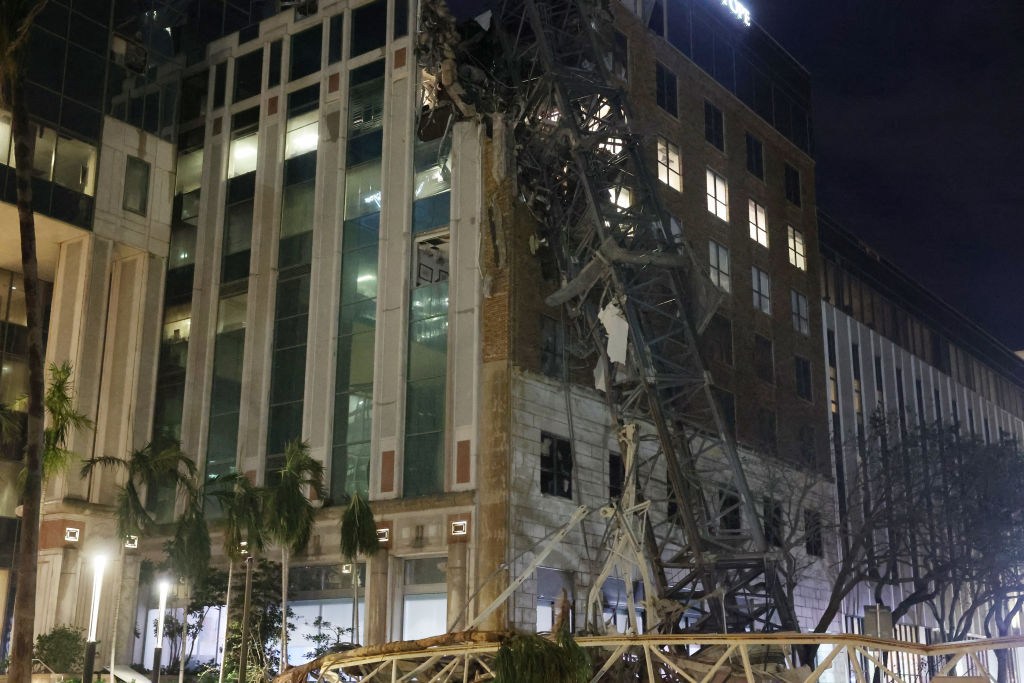A crane sits on the street after crashing down into the building housing the Tampa Bay Times offices after the arrival of Hurricane Milton on October 10, 2024, in St. Petersburg. Milton, which comes just after the recent catastrophic Hurricane Helene, landed into Florida’s Gulf Coast late Wednesday evening as a Category 3 storm causing extensive flooding and damage. (Photo by Spencer Platt/Getty Images)
Days after Hurricane Milton caused widespread damage to areas still rebuilding after Hurricane Ian two years ago, Gov. Ron DeSantis on Friday dismissed a suggestion that the state limit development in coastal areas vulnerable to dangerous tropical storms.
Hurricane Milton made landfall near Sarasota Wednesday evening, bringing high winds, storm surge, and flooding to much of Florida’s west coast and central peninsula. The storm spun off tornadoes, claiming 17 lives, including at least five in St. Lucie County.
DeSantis did not provide a comprehensive update on the storm’s death toll during a morning news conference in St. Petersburg.
Milton arrived roughly two weeks after Hurricane Helene caused extensive damage in Florida’s Big Bend before spinning up through the Southeast causing catastrophic flooding. It was the third hurricane in the Big Bend within the past year or so.
Despite the damage, DeSantis said government prohibitions on rebuilding in areas repeatedly demolished by natural disasters are off the table.
“The reality is, is people work their whole lives and work hard to be able to live in environments that are really, really nice, and they have a right to make those decisions with their property as they see fit,” DeSantis said in response to a question during a news conference in Bradenton Beach.
“It is not the role of government to forbid them or to force them to dispose or utilize their property in a way that they do not think is best for them,” the governor said.
DeSantis said the demand to live in Florida can override the threat of natural disasters.
“These things are very tough. What I see is people have a lot of resilience,” DeSantis said, summarizing damage from hurricanes Ian and Michael, which heavily damaged the Panhandle in 2018.
“And a lot of people were saying, ‘Oh, you know, are people going to want to live in Southwest Florida?’ And, like, within two weeks [after Ian] you had people buying up homes. I mean, people wanted to get down there. So, I think that there’s always going to be a demand to live in a beautiful part of the world.”
According to the governor’s office, more than 1,600 people and 140 pets had been rescued from floodwaters, rubble, or other hazards as of Friday morning.
Restoring power
As of Friday afternoon, 2.26 million customers across Florida remained without power, down from the approximately 4 million right after Milton’s landfall.
“Yesterday was a day of damage assessment and the beginning to restore critical customers, hospitals, water treatment plants, shelters, 911 centers,” Duke Energy Florida President Melissa Seixas said. “Today we started full bore, 1,000% moving very quickly into restoration so we will begin to see these numbers quickly decrease.”
In estimating how long power restoration might take for her customers, Seixas said, “This is not weeks. This is days.”
While workers restore power, clear debris, and pursue other recovery efforts, state Emergency Management Director Kevin Guthrie pleaded for people to refrain from sight-seeing.
“Don’t disaster sight see. We have a lot of people that are out here doing great work, well over 50,000, probably closer to 60-65,000 responders, electrical workers, all doing really, really good work right now,” Guthrie said. “But we need you to stay out of our way, just simply put. … We really, really need your cooperation on this.”
Amid widespread gasoline shortages, DeSantis said there is “a lot of fuel in the ports,” although moving it to consumers is a matter of distributing it to gas stations that have generators, dispensing it straight out of trucks, or restoring power to gas stations.
During an afternoon news conference in Englewood, Guthrie said 140,000 gallons out of the state’s 1-million-gallon reserve has been distributed to 20 gas stations in the state. Nineteen gas stations have received generators, Guthrie said.
State officials are being careful about deploying generators to gas stations, he said.
“We’re also communicating with our electrical providers, because it doesn’t make sense for us to pour a lot of money into something that’s going to correct itself in 12 to 24 hours,” Guthrie said.
DeSantis said Port Tampa Bay did not “suffer much structural damage” and that resuming operations will depend on restoring power.
Crane collapse
A construction crane in St. Petersburg collapsed during the storm, causing damage to a building housing the Tampa Bay Times. DeSantis and Guthrie blamed a lack of common sense by its operators in leaving it up as forecasters warned the storm was coming.
“Common sense has got to prevail,” Guthrie said. The state “cannot hold everybody’s hand and do everything for them,” he added.
DeSantis agreed the state should not have to regulate taking cranes down in advance of a storm.
“Do you have to really, kind of, like, crack down from the state to do it? I would hope not,” DeSantis said. “And I think most of the time in Florida that is handled very appropriately, but I think it just takes a little bit of common sense.”
GET THE MORNING HEADLINES.

